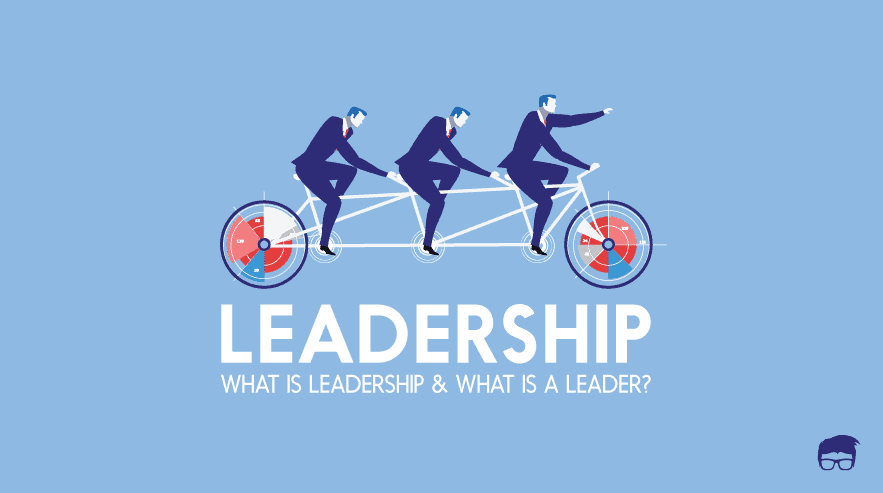Are leaders born or made?
A study by the University of Illinois suggests that 30% of leadership ability is genetic and 70% of the leadership skills are to be developed or made.
To be able to give a better answer to the above question, let us try to understand what leadership is and what it takes to be a good leader.
What Is Leadership?
Leadership is the process of social influence to motivate people to achieve a shared set of objectives.
The two key phrases to note here are-
- Social influence: Leaders tend to cause a change in the behaviour of people by establishing an influencer-follower relationship with them.
- Shared set of objectives: The main aim of a leader is to achieve a set of goals with the help of focused efforts put in by people who believe in these goals.
There is a need for leadership in almost all walks of like; not only in political or business scenarios but also at homes. This being said, it becomes important to know who is a leader and what characteristics a good leader possesses.
Who Is A Leader?
A leader is a person who takes the responsibility of leading a group of people or an organisation towards the accomplishment of a vision.
They do so by –
- Motivating and inspiring their followers
- Building a sense of trust and accountability
- Engaging followers in activities that channelise their efforts in one direction
Characteristics Of A Good Leader
Practically, there is no perfect structure that explains how to be a good leader, but there are some basic characteristics that a good leader may project:
- Vision: It is the leader’s vision that the followers try to achieve by making it their own.
- Communication: Possessing good communication skills is the key to get people to work towards a vision. Communication skills not only include speaking skills but it also includes listening skills. As a leader, it is as important to listen to the followers as it is to communicate the vision.
- Confidence: Only when the leader is confident can the followers trust them. It is the leader’s confidence in themselves and their followers that motivates the followers to accomplish goals.
- Persuasion: A leader’s speech should be persuasive to influence people to work for them.
- Decision Making: Decision making is the most critical quality a leader should possess. Because it is the decisions of the leader that the followers look up to and it is their decisions that will affect the entire team or organisation for that matter.
- Empathy: Listening to the followers and understanding their problems will enable the leader to know why his or her team is not performing well and come up with solutions for the same.
Importance Of Leadership In Organisations
Leadership plays a vital role in organisations. Be it leadership at the senior most level or at the team level. Some reasons why leadership is important are:
- Keeps employees motivated: Effective leadership inspires and motivates employees to supersede their personal interests and work towards the accomplishment of goals set for the progress of a team or the organisation as a whole.
- Keeps everyone focused: Since a leader puts forth a clear vision for the organisation, it becomes easy for the team to focus their efforts to keep themselves aligned with the leader’s vision. It leads to channelizing the energy of the entire team in a single direction which increases the impact of the team’s efforts.
- Helps in conflict management: A leader helps to keep the team in coordination and harmony. Any conflicts that exist within the team can be resolved with the help of the team leader. Effective conflict management by leaders results in a team working with high productivity and with mutual respect for each other. It also leads to a positive and motivating work environment.
Types Of Leadership Styles
There are different leadership styles to suit different situations. Leadership can be categorised into the following styles:
Transformational Leadership
Transformational leadership is giving employees the freedom to be creative and take responsibility for their own decisions. A transformational leader communicates his or her vision to the employees and then let them work towards achieving that vision by letting them work in autonomy. This enables the employees to come up with new innovative solutions to achieve objectives and stay motivated.
Some characteristics of a transformational leader are:
- Promoting creativity
- Providing autonomy to the team
- Clear vision for future
Transformational leadership is best suited for organisations that are looking to transform their brand image or bring about new innovative solutions into untapped markets.
Steve Jobs is one example of a transformational leader. He had a vision for Apple which was worked upon by the employees of Apple. He promoted innovation which lead to delivery of creative solutions by the employees.
Transactional Leadership
Transactional Leadership is the antithesis of transformational leadership. Unlike transformational leadership, transactional leadership works on the principle of punish and reward. It is about getting the employees to complete their jobs by a stick and carrot approach. The leaders constantly supervise and monitor employee performance. Transactional leader’s main aim is to get the routine tasks done in the most efficient manner possible.
Listed below are some characteristics of a transactional leader are:
- Consistent supervision and direction
- Extrinsic motivator
- Rigidity in instructions
When an organisation is looking at increasing everyday efficiency of its team with consistent reporting, transactional leadership seems to be the best fit.
Bill Gates is one example of a transactional leader. It is said that he used to visit the product teams to make sure that the teams were on track with their activities and used to ask them questions until he was satisfied that the team is working correctly.
Charismatic Leadership
Leaders with a charismatic leadership style are the ones who use their personality and persuasive skills to get followers to do what they believe in. Their communication skill is the most admired by their followers. They are the ones who connect with their followers at an emotional level because they are profound communicators.
Charismatic leaders may have the following characteristics:
- Exceptional communication skills
- Persuasive and assertive
- High Emotional Quotient (EQ)
Charismatic leadership is most effective in situations where the leader needs to bridge the emotional gap with their followers. Situations which require the leaders to empathise with their followers can be best tackled by adopting charismatic leadership.
Political leaders like Barack Obama and Narendra Modi are examples of people with charismatic leadership style. They connect with their followers on an emotional level and communicate their message in a very persuasive way.
Democratic Leadership
As the name suggests, democratic leadership style practices democracy. All the decisions are made after taking into consideration all team members inputs. Though the power of decision making lies with the leader, but he or she takes into account what their team members have to say. Such a style of leadership promotes freedom of expression in the team and encourages the team members to be vocal about their opinions.
Here is a list of characteristics that a democratic leader may possess:
- Empowering the group
- Fair decision making
- Task delegation
A team that is made up of members who are opinionated and believe in team work can be best supported by adapting to democratic leadership style.
A jazz band portrays the democratic leadership style perfectly. Even though the band often lead by a conductor or bandleader who is responsible to ensemble various sounds and harmonies into one cohesive production, there are certain sections where each musician gets the freedom to improvise and show off their creative side.
Bureaucratic Leadership
Bureaucratic style of leadership is the one in which leaders generally tend to not accept ideas that are non-traditional. Bureaucratic leaders, just like democratic leaders, listen to their team member’s opinions and views but tend to reject anything that does not seem to be in alignment with a set guideline. Such a leadership style may lead to a lack of creativity in the team.
A leader with a bureaucratic leadership style may demonstrate the following characteristics:
- Lack of creative freedom
- Controlled and structured leadership
- Abider of status quo
An organisation that wants to work as per the set rules, is resilient to change and follows a strict hierarchy can be effectively led by bureaucratic leaders.
An example of a bureaucratic leader could be Winston Churchill. During World War when Winston Churchill was prime minister of the UK, he led the country with control, structure and power. Though his bureaucratic leadership style resulted in a victory in the Second World War for them, it also led to his downfall after the war.
Laissez-Faire Leadership
Laissez-Faire is a French word which means ‘allow to do’. So Laissez-Faire leadership style means letting things happen the way they are and not interfering in between. Laissez-Faire leaders tend to leave the team to be on their own and do not exercise their control powers.
Characteristics of a Laissez-Faire leader may be:
- Very little or no guidance to the team
- Complete freedom of decision making
- Facilitator of resources
This style of leadership when followed with employees that are self-motivated and self-starters would work best. But if adopted for employees that are complacent and need a push to do tasks, it could lead to the downfall of the team.
Warren Buffet is a famous example of a Laissez-Faire leader. He is believed to leave his team to work on its own and achieve results. He gets the resources managed by making investments and leaves it to his managers to achieve goals.
Final Thoughts
Some people are born leaders. But, it does not mean leaders cannot be made. Behavioural theories believe that leaders can be made by learning and observing various leaders and their leadership styles. One can always learn and practice the skills to be a leader. A notable point here is that it is important to match the right leadership style with the right situation for effective and quantifiable results.
Go On, Tell Us What You Think!
Did we miss something? Come on! Tell us what you think about our article on what is leadership in the comments section.
A startup consultant, digital marketer, traveller, and philomath. Aashish has worked with over 20 startups and successfully helped them ideate, raise money, and succeed. When not working, he can be found hiking, camping, and stargazing.









